Investigating the Use of ChatGPT for the Scheduling of Construction Projects
Abstract
1. Introduction
Aims and Contribution
- Explore the possible applications and limitations of a rapidly growing and powerful tool for construction scheduling and resource loading.
- Conduct a preliminary case study involving multiple users applying GPT to generate a resource-loaded project schedule for a simple project based on a given detailed natural language description input (i.e., prompt).
- Evaluate the results obtained from the participants in the case study based on parameters such as accuracy, efficiency, clarity, coherence, reliability, relevance, consistency, scalability, and adaptability.
2. Literature Review
2.1. Language Representation Models
2.1.1. Generative Pre-Trained Transformer (GPT)
2.1.2. Bidirectional Encoder Representations from Transformers (BERT)
2.1.3. Text-to-Text Transfer Transformer (T5) Multi-Tasking Learning
2.2. Automation of Construction Scheduling
2.2.1. BIM-Driven Schedule Generation
2.2.2. Machine Learning-Based Schedule Generation
3. Methodology
4. Case Study
“A set of instructions on a construction project will be provided. You will store the provided information, and you won’t provide any answers to the initial prompt until asked otherwise”.
“A new partition needs to be done in an already existent space, where the new partition is grouted with the existing walls. The details of the room to be partitioned are the following: the room is rectangular shaped, 4 m by 4 m in total. The walls are made of concrete masonry units. The height of the walls is 3 m, and the width is 20 cm. The new partition needs to be made out of concrete masonry units as well. The partition is meant to split the original space in half, resulting in two individual spaces of approximately 4 m by 2 m. The partition needs to account for the installation of a single solid, two-panel wooden door of 0.8 m in width by 2.1 m in height and 35 mm thickness that will communicate the two new spaces. After the partition is made, it needs to be plastered with two layers of stucco and painted with two layers of white latex paint on both sides of the wall. No electrical or plumbing installation is needed. No ceiling work is needed. The floor is cement screed. The work needs to be completed in less than three weeks”.
“Can you come out with a suitable project schedule”?
“Based on the details of the work to be completed, extract the information in the following structure ‘task name/task priority/task dependencies/number of people needed/expected duration of task.”
5. Results and Discussion
| Task No. | Task Name | Task Dependencies | People Needed * | Expected Duration |
|---|---|---|---|---|
| 1 | Inspect the existing space and check proposed work is in line with existing conditions | - | 1–2 | 1 day |
| 2 | Prepare the work area and protect surrounding areas as needed | 1 | 1–2 | 1 |
| 3 | Measure and mark the location of the new partition, including the location for opening (door) | 1 | 1 | 1 |
| 4 | Install CMU for new partition | 1 | 2 | 3 |
| 5 | Install framing for the new door | 4 | 1–2 | 1 |
| 6 | Apply the first stucco layer to the CMU wall—includes curing time | 4 SS + 2 | 1–2 | 3 |
| 7 | Apply the second stucco layer to the CMU wall—includes curing time | 6 | 1–2 | 4 |
| 8 | Install and adjust the wooden door | 7 | 1 | 0.5 |
| 9 | Protect the door in preparation for the painting of the new CMU partition wall | 8 | 1 | 0.5 |
| 10 | Finish wall (prime, paint, apply two layers—allow drying time per manufacturer’s recommendations) | 7 | 2 | 4 |
| 11 | Clean-up and final inspection | 10 | 1 | 1 |
| TOTAL | 15.5 days ** |
“The new wall that needs to be built for the partition needs to have a couple of electrical sockets. Can you include that task in your schedule and regenerate it”?
“Based on the information above, can you provide a cost estimate for labor and materials needed”?
Limitations
6. Conclusions and Future Work
Author Contributions
Funding
Data Availability Statement
Acknowledgments
Conflicts of Interest
Appendix A
| Participant | Task Name | Dependencies | Priority * | People Needed | Expected Duration |
|---|---|---|---|---|---|
| 1 | 1. Demolition of existing wall | - | H | 2–3 | 1 day |
| 2. Framing of partition | 1 | H | 2–3 | 2 days | |
| 3. Measurement and cutting of wooden door | 2 | M | 1–2 | 1 day | |
| 4. Installation of wooden door | 3 | M | 1–2 | 1 day | |
| 5. Plastering of partition | 4 | L | 1–2 | 2 days | |
| 6. Final touch-ups and clean-up | 5 | L | 2 | 2 days | |
| 7. Painting of partition | 5 | L | 2 | 2 days | |
| TOTAL | 11 days | ||||
| 2 | 1. Demolition of existing wall | - | H | 2–3 | 2 days |
| 2. Lay the foundation for the new partition | 1 | H | 2–3 | 3 days | |
| 3. Build the partition wall up to the ceiling | 2 | H | 2–3 | 3 days | |
| 4. Install the wooden door | 3 | M | 2 | 2 days | |
| 5. Apply the first layer of stucco | 4 | M | 2–3 | 2 days | |
| 6. Apply the second layer of stucco | 5 | M | 2–3 | 2 days | |
| 7. Apply the first layer of paint | 6 | M | 2–3 | 2 days | |
| 8. Apply the second layer of paint | 7 | M | 2–3 | 2 days | |
| 9. Final inspection and clean-up | 8 | H | 2–3 | 1 day | |
| TOTAL | 19 days | ||||
| 3 | 1. Prepare the site | - | H | 2–3 | 1 day |
| 2. Measure and mark the existing space | 1 | H | 2 | 1 day | |
| 2. Excavation for the new partition’s foundation | 2 | H | 2–3 | 2 days | |
| 4. Building the new partition | 3 | H | 4 | 4 days | |
| 5. Install the wooden door | 4 | H | 2 | 1 day | |
| 6. Apply two layers of stucco to both sides of the partition | 3 | H | 2 | 1 day | |
| 7. Apply two layers of white latex paint to both sides of the partition | 6 | H | 2 | 1 day | |
| 8. Clean up the site | 7 | H | 2 | 1 day | |
| TOTAL | 12 days | ||||
| 4 | 1. Demolition of existing wall | - | H | 2–3 | 1 day |
| 2. Excavation and preparation of foundation for new partition | 1 | H | 2–3 | 1 day | |
| 3. Installation of steel reinforcement for new partition | 2 | H | 2–3 | 1 day | |
| 4. Pouring of concrete for new partition | 3 | H | 2–3 | 1 day | |
| 5. Erection of new partition using concrete masonry units | 4 | H | 2–3 | 2 days | |
| 6. Installation of wooden door | 5 | H | 1–2 | 1 day | |
| 7. Plastering of new partition with first layer of stucco | 5 | H | 1–2 | 1 day | |
| 8. Plastering of new partition with second layer of stucco | 7 | H | 1–2 | 1 day | |
| 9. Painting of new partition with first layer of white latex paint | 8 | H | 1–2 | 1 day | |
| 10. Painting of new partition with second layer of white latex paint | 9 | H | 1–2 | 1 day | |
| 11. Clean-up and final inspection | 10 | H | 1–2 | 1 day | |
| TOTAL | 13 days | ||||
| 5 | 1. Preparation and planning | - | H | 2–3 | 2 days |
| 2. Demolition of existing walls | 1 | H | 2–3 | 2 days | |
| 3. Construction of new partition | 2 | H | 2–3 | 2 days | |
| 4. Installation of wooden door | 3 | H | 1–2 | 2 days | |
| 5. Plastering | 3 | H | 2–3 | 2 days | |
| 6. Painting | 5 | H | 2–3 | 2 days | |
| 7. Clean-up and final inspection | 6 | H | 2–3 | 2 days | |
| TOTAL | 14 days | ||||
| 6 | 1. Preparation and planning | - | H | 2–3 | 2 days |
| 2. Demolition | 1 | H | 2–3 | 3 days | |
| 3. Masonry work | 2 | H | 3–4 | 3 days | |
| 4. Door installation | 3 | H | 2–3 | 2 days | |
| 5. Plastering and painting | 4 | M | 2–3 | 3 days | |
| 6. Clean-up and final inspection | 5 | L | 2–3 | 2 days | |
| TOTAL | 15 days |
Appendix B

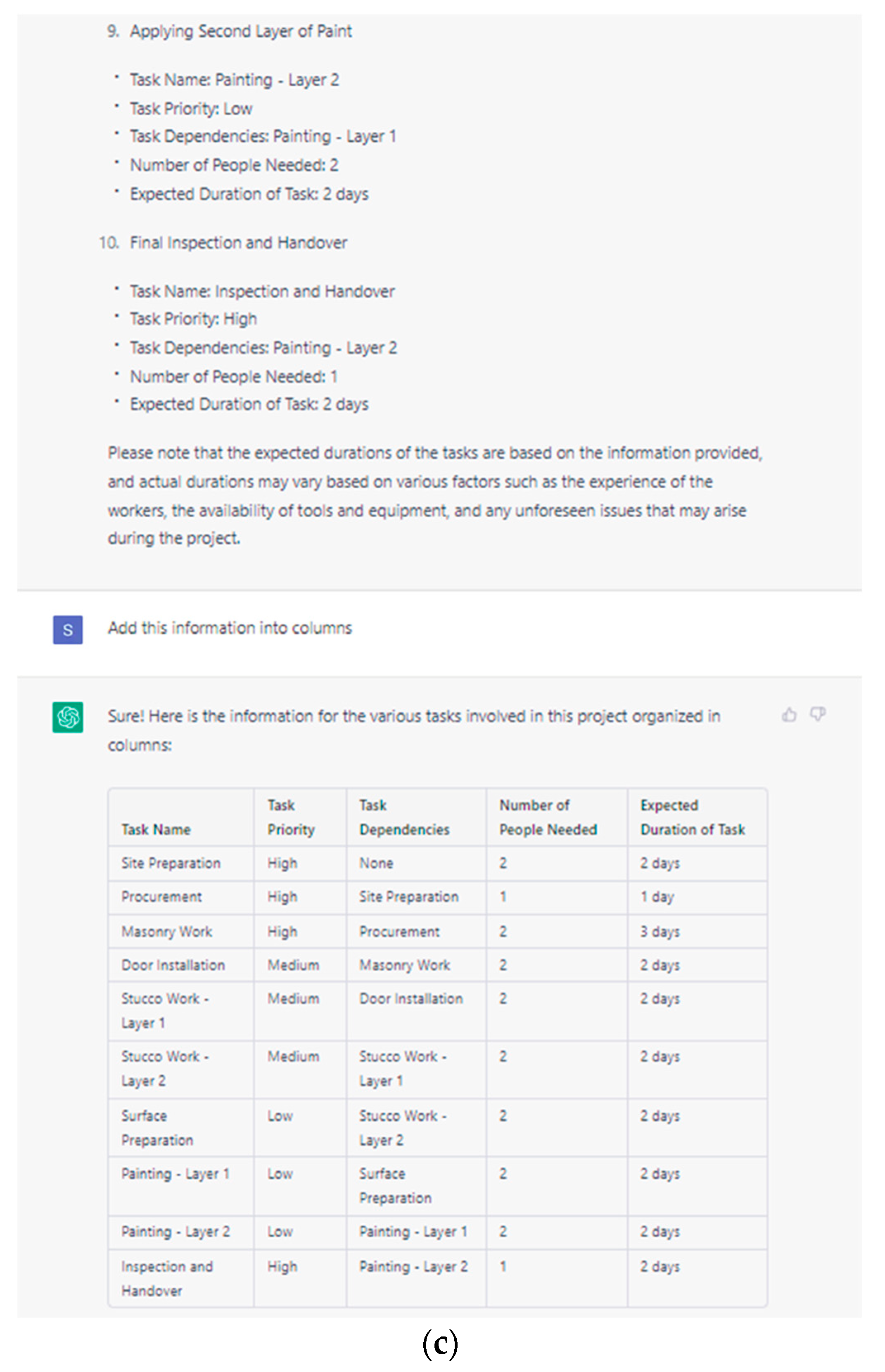
References
- Chowdhary, K.R. Natural Language Processing. In Fundamentals of Artificial Intelligence; Chowdhary, K.R., Ed.; Springer: New Delhi, India, 2020; pp. 603–649. [Google Scholar] [CrossRef]
- Xue, X.; Hou, Y.; Zhang, J. Automated Construction Contract Summarization Using Natural Language Processing and Deep Learning. In Proceedings of the 39th International Symposium on Automation and Robotics in Construction (ISARC 2022), Bogotá, Colombia, 13–15 July 2022; IAARC Publications. pp. 459–466. [Google Scholar] [CrossRef]
- Di Giuda, G.M.; Locatelli, M.; Schievano, M.; Pellegrini, L.; Pattini, G.; Giana, P.E.; Seghezzi, E. Natural Language Processing for Information and Project Management. In Digital Transformation of the Design, Construction and Management Processes of the Built Environment; Daniotti, B., Gianinetto, M., Della Torre, S., Eds.; Springer International Publishing: Cham, Switzerland, 2020; pp. 95–102. [Google Scholar] [CrossRef]
- Zou, Y.; Kiviniemi, A.; Jones, S.W. Retrieving similar cases for construction project risk management using Natural Language Processing techniques. Autom. Constr. 2017, 80, 66–76. [Google Scholar] [CrossRef]
- Zhang, J.; El-Gohary, N.M. Integrating semantic NLP and logic reasoning into a unified system for fully-automated code checking. Autom. Constr. 2017, 73, 45–57. [Google Scholar] [CrossRef]
- Tixier, A.J.-P.; Hallowell, M.R.; Rajagopalan, B.; Bowman, D. Automated content analysis for construction safety: A natural language processing system to extract precursors and outcomes from unstructured injury reports. Autom. Constr. 2016, 62, 45–56. [Google Scholar] [CrossRef]
- Ding, Y.; Ma, J.; Luo, X. Applications of natural language processing in construction. Autom. Constr. 2022, 136, 104169. [Google Scholar] [CrossRef]
- Hassan, F.U.; Le, T.; Lv, X. Addressing Legal and Contractual Matters in Construction Using Natural Language Processing: A Critical Review. J. Constr. Eng. Manag. 2021, 147, 03121004. [Google Scholar] [CrossRef]
- Cho, J.; Lee, G. A Chatbot System for Construction Daily Report Information Management. In Proceedings of the 36th International Symposium on Automation and Robotics in Construction (ISARC 2019), Banff, AB, Canada, 21–24 May 2019; IAARC Publications: Waterloo, ON, Canada, 2019; pp. 429–437. [Google Scholar] [CrossRef]
- Amer, F.; Jung, Y.; Golparvar-Fard, M. Transformer machine learning language model for auto-alignment of long-term and short-term plans in construction. Autom. Constr. 2021, 132, 103929. [Google Scholar] [CrossRef]
- Naseem, U.; Razzak, I.; Khan, S.K.; Prasad, M. A Comprehensive Survey on Word Representation Models: From Classical to State-of-the-Art Word Representation Language Models. Trans. Asian Low-Resour. Lang. Inf. Process. 2021, 20, 74. [Google Scholar] [CrossRef]
- Schomacker, T.; Tropmann-Frick, M. Language Representation Models: An Overview. Entropy 2021, 23, 1422. [Google Scholar] [CrossRef] [PubMed]
- Locatelli, M.; Seghezzi, E.; Pellegrini, L.; Tagliabue, L.C.; Di Giuda, G.M. Exploring Natural Language Processing in Construction and Integration with Building Information Modeling: A Scientometric Analysis. Buildings 2021, 11, 583. [Google Scholar] [CrossRef]
- Brown, T.B.; Mann, B.; Ryder, N.; Subbiah, M.; Kaplan, J.; Dhariwal, P.; Neelakantan, A.; Shyam, P.; Sastry, G.; Askell, A.; et al. Language Models are Few-Shot Learners. arXiv 2020. [Google Scholar] [CrossRef]
- Ray, T. ChatGPT Is “Not Particularly Innovative,” and “Nothing Revolutionary”, Says Meta’s Chief AI Scientist, ZDNET. 2023. Available online: https://www.zdnet.com/article/chatgpt-is-not-particularly-innovative-and-nothing-revolutionary-says-metas-chief-ai-scientist/ (accessed on 27 January 2023).
- Korngiebel, D.M.; Mooney, S.D. Considering the possibilities and pitfalls of Generative Pre-trained Transformer 3 (GPT-3) in healthcare delivery. NPJ Digit. Med. 2021, 4, 93. [Google Scholar] [CrossRef] [PubMed]
- Floridi, L.; Chiriatti, M. GPT-3: Its Nature, Scope, Limits, and Consequences. Minds Mach. 2020, 30, 681–694. [Google Scholar] [CrossRef]
- Devlin, J.; Chang, M.-W.; Lee, K.; Toutanova, K. BERT: Pre-training of Deep Bidirectional Transformers for Language Understanding. arXiv 2019. [Google Scholar] [CrossRef]
- Hassan, H.A.M.; Marengo, E.; Nutt, W. A BERT-Based Model for Question Answering on Construction Incident Reports. In Natural Language Processing and Information Systems; Rosso, P., Basile, V., Martínez, R., Métais, E., Meziane, F., Eds.; Springer International Publishing: Cham, Switzerland, 2022; pp. 215–223. [Google Scholar] [CrossRef]
- Moon, S.; Chi, S.; Im, S.-B. Automated detection of contractual risk clauses from construction specifications using bidirectional encoder representations from transformers (BERT). Autom. Constr. 2022, 142, 104465. [Google Scholar] [CrossRef]
- Yao, D.; García de Soto, B. A corpus database for cybersecurity topic modeling in the construction industry. In Proceedings of the 40th International Symposium on Automation and Robotics in Construction (ISARC 2023), Chennai, India, 4–7 July 2023. [Google Scholar]
- Raffel, C.; Shazeer, N.; Roberts, A.; Lee, K.; Narang, S.; Matena, M.; Zhou, Y.; Li, W.; Liu, P.J. Exploring the Limits of Transfer Learning with a Unified Text-to-Text Transformer. arXiv 2020. [Google Scholar] [CrossRef]
- Jung, Y.; Fouad, A.; Golparvar-Fard, M. A systematic review on the requirements on BIM maturity and formal representation of sequencing knowledge for automated construction scheduling. In Proceedings of the 38th International Conference of CIB, Luxembourg, 11–15 October 2021; pp. 429–436. Available online: https://itc.scix.net/paper/w78-2021-paper-043 (accessed on 13 January 2023).
- Aljebory, K.M.; QaisIssam, M. Developing AI Based Scheme for Project Planning by Expert Merging Revit and Primavera Software. In Proceedings of the 2019 16th International Multi-Conference on Systems, Signals & Devices (SSD), Istanbul, Turkey, 21–24 March 2019; pp. 404–412. [Google Scholar] [CrossRef]
- Wang, Z.; Azar, E.R. BIM-based draft schedule generation in reinforced concrete-framed buildings. Constr. Innov. 2019, 19, 280–294. [Google Scholar] [CrossRef]
- Hong, Y.; Xie, H.; Agapaki, E.; Brilakis, I. Graph-Based Automated Construction Scheduling without the Use of BIM. J. Constr. Eng. Manag. 2023, 149, 05022020. [Google Scholar] [CrossRef]
- Awada, M.; Srour, F.J.; Srour, I.M. Data-Driven Machine Learning Approach to Integrate Field Submittals in Project Scheduling. J. Manag. Eng. 2021, 37, 04020104. [Google Scholar] [CrossRef]
- Lin, J.J.; Golparvar-Fard, M. Visual Data and Predictive Analytics for Proactive Project Controls on Construction Sites. In Advanced Computing Strategies for Engineering; Smith, I.F.C., Domer, B., Eds.; Springer International Publishing: Cham, Switzerland, 2018; pp. 412–430. [Google Scholar] [CrossRef]
- Hong, Y.; Xie, H.; Bhumbra, G.; Brilakis, I. Comparing Natural Language Processing Methods to Cluster Construction Schedules. J. Constr. Eng. Manag. 2021, 147, 04021136. [Google Scholar] [CrossRef]

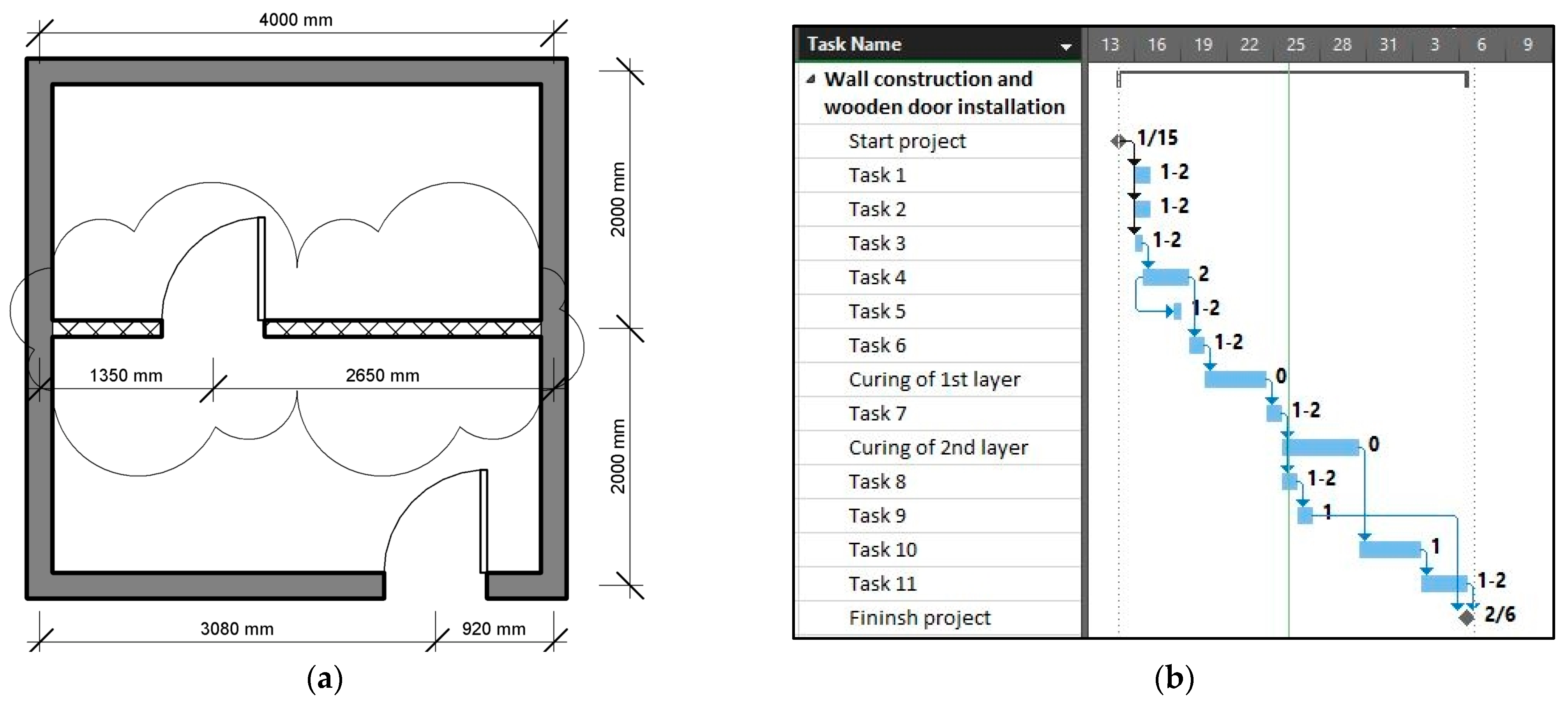
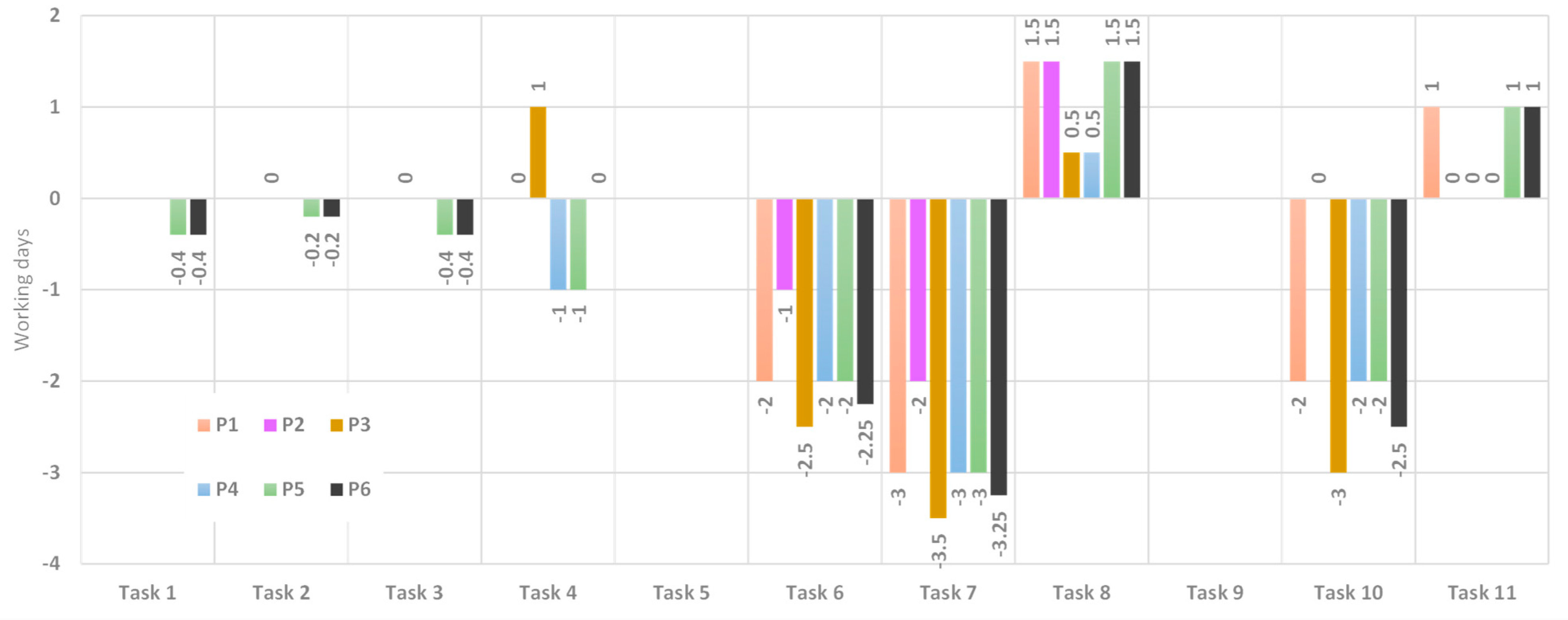

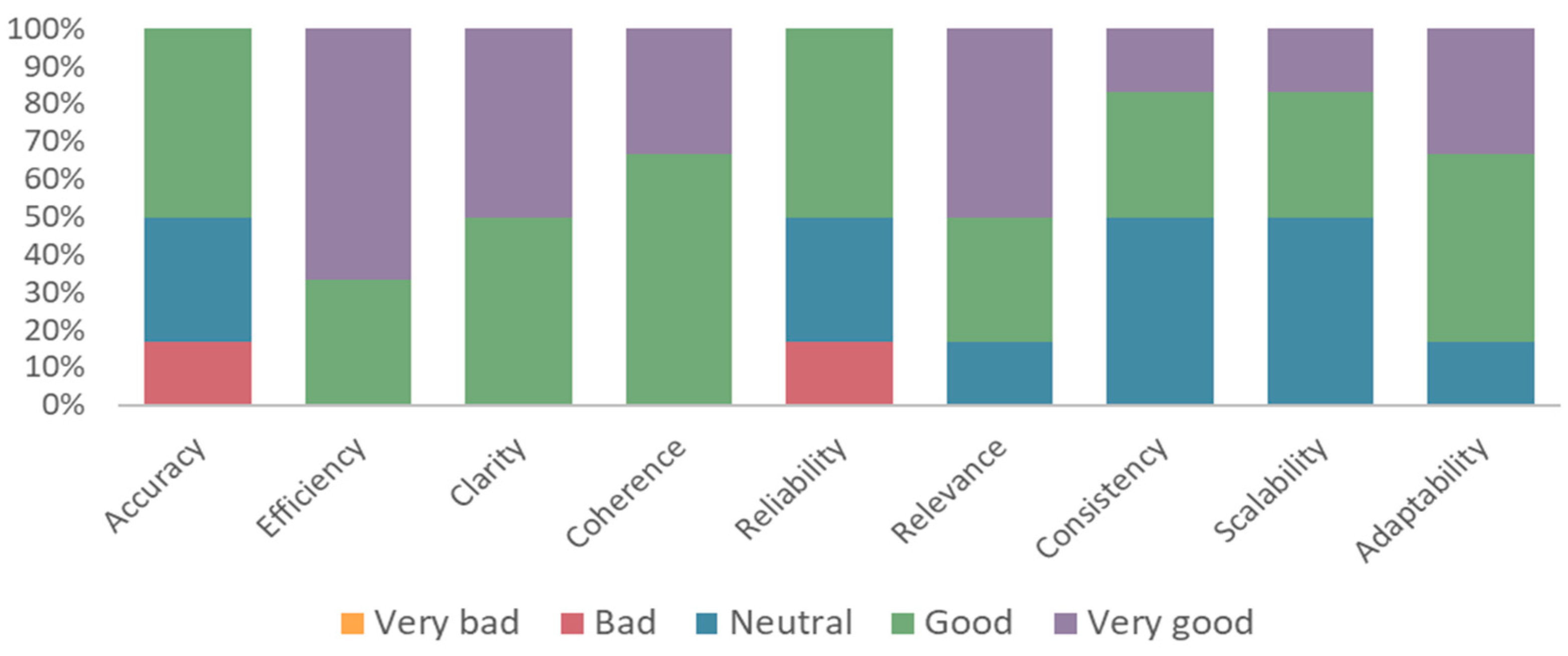
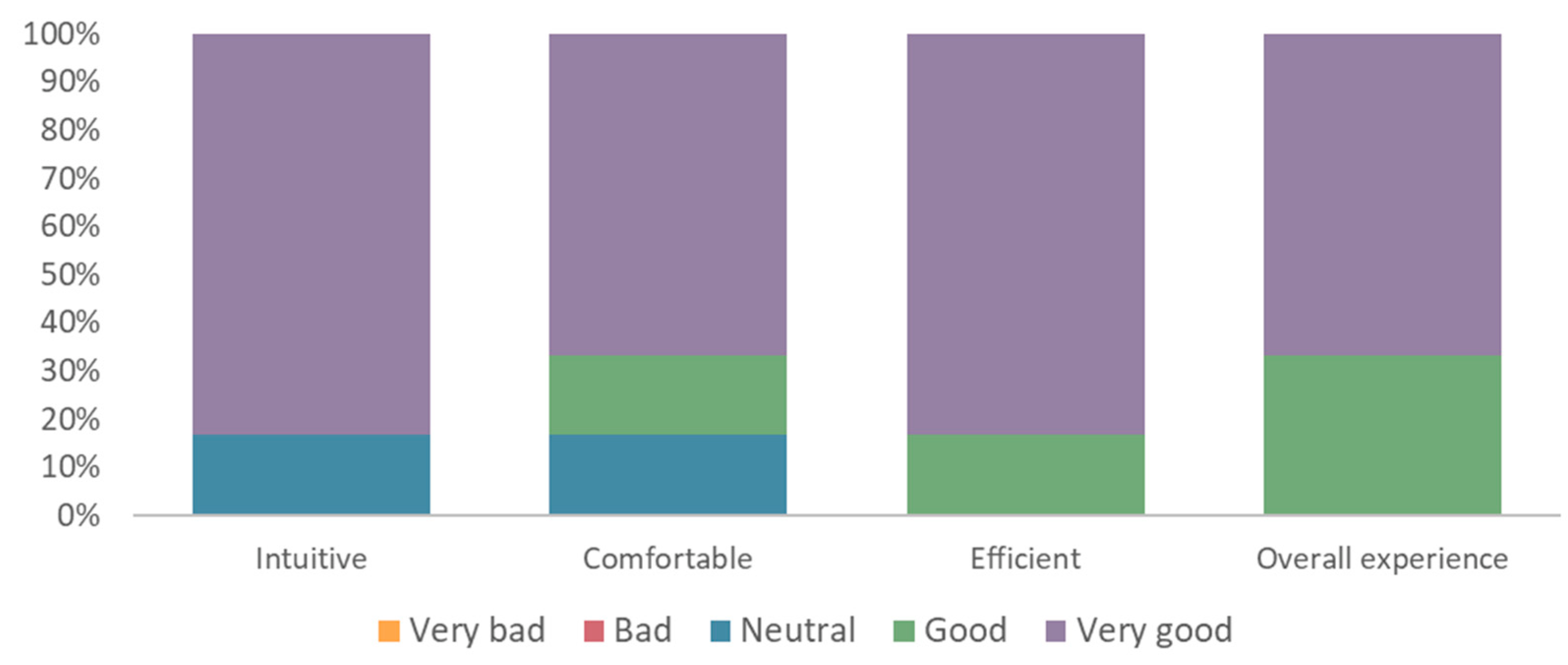
| Participant | Experience | Academic Background |
|---|---|---|
| 1 | 2+ years in the academic field | Civil Engineering, M.Sc. |
| 2 | 2+ years in the industry 2+ years in the academic field | Civil Engineering, M.Sc. |
| 3 | 7+ years in the academic field 2+ years in the industry | Civil Engineering, Ph.D. |
| 4 | 10+ years in the academic field 15+ years in the industry | Civil Engineering and Construction Management, Ph.D. |
| 5 | 2+ years in the academic field | Civil Engineering, B.Sc. |
| 6 | 7+ years in the academic field 2+ years in the industry | Electrical Engineering, Ph.D. |
| Task No. | Task Name (Baseline) | Participant | |||||
|---|---|---|---|---|---|---|---|
| 1 | 2 | 3 | 4 | 5 | 6 | ||
| 1 | Inspect the existing space and check proposed work is in line with existing conditions | ✗ | ✗ | ✗ | ✗ | ✓ | ✓ |
| 2 | Prepare the work area and protect surrounding areas as needed | ✗ | ✗ | ✓ | ✗ | ✓ | ✓ |
| 3 | Measure and mark the location of the new partition, including the location for opening (door) | ✗ | ✗ | ✓ | ✗ | ✓ | ✓ |
| 4 | Install CMU for new partition | ✗ | ✓ | ✓ | ✓ | ✓ | ✓ |
| 5 | Install framing for the new door | ✗ | ✗ | ✗ | ✗ | ✗ | ✗ |
| 6 | Apply the first stucco layer to the CMU wall—includes curing time | ✓ | ✓ | ✓ | ✓ | ✓ | ✓ |
| 7 | Apply the second stucco layer to the CMU wall—includes curing time | ✓ | ✓ | ✓ | ✓ | ✓ | ✓ |
| 8 | Install and adjust the wooden door | ✓ | ✓ | ✓ | ✓ | ✓ | ✓ |
| 9 | Protect the door in preparation for the painting of the new CMU partition wall | ✗ | ✗ | ✗ | ✗ | ✗ | ✗ |
| 10 | Finish wall (prime, paint, apply two layers—allow drying time per manufacturer’s recommendations) | ✓ | ✓ | ✓ | ✓ | ✓ | ✓ |
| 11 | Clean-up and final inspection | ✓ | ✓ | ✓ | ✓ | ✓ | ✓ |
| Task Name | Dependencies | People Needed | Expected Duration |
|---|---|---|---|
| Install electrical sockets | Building the new partition | 2 | 4 h |
Disclaimer/Publisher’s Note: The statements, opinions and data contained in all publications are solely those of the individual author(s) and contributor(s) and not of MDPI and/or the editor(s). MDPI and/or the editor(s) disclaim responsibility for any injury to people or property resulting from any ideas, methods, instructions or products referred to in the content. |
© 2023 by the authors. Licensee MDPI, Basel, Switzerland. This article is an open access article distributed under the terms and conditions of the Creative Commons Attribution (CC BY) license (https://creativecommons.org/licenses/by/4.0/).
Share and Cite
Prieto, S.A.; Mengiste, E.T.; García de Soto, B. Investigating the Use of ChatGPT for the Scheduling of Construction Projects. Buildings 2023, 13, 857. https://doi.org/10.3390/buildings13040857
Prieto SA, Mengiste ET, García de Soto B. Investigating the Use of ChatGPT for the Scheduling of Construction Projects. Buildings. 2023; 13(4):857. https://doi.org/10.3390/buildings13040857
Chicago/Turabian StylePrieto, Samuel A., Eyob T. Mengiste, and Borja García de Soto. 2023. "Investigating the Use of ChatGPT for the Scheduling of Construction Projects" Buildings 13, no. 4: 857. https://doi.org/10.3390/buildings13040857
APA StylePrieto, S. A., Mengiste, E. T., & García de Soto, B. (2023). Investigating the Use of ChatGPT for the Scheduling of Construction Projects. Buildings, 13(4), 857. https://doi.org/10.3390/buildings13040857









